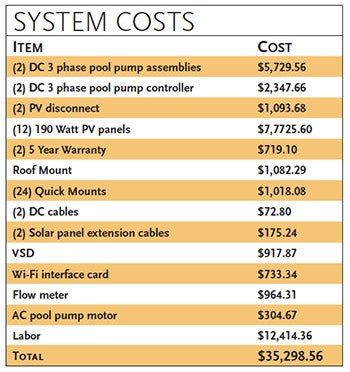Utility bill savings are traditionally the No. 1 design imperative for pool pumps; we want them to consume less electricity from the grid and cause less air pollution. Two of the most successful movements on this front in recent years have been the development of solar pumps and variable speed pumps.
Solar pumps rely on the sun instead of a power plant to move electrons and turn shafts, thereby lowering the cost of power, while the advent of variable speed pumping allows the operator to dial down flow and take advantage of the Affinity Law, dramatically reducing the power required to move and filter pool water.
 Click to enlarge
Click to enlarge
Wouldn't it be great if we could combine the two. What an idea!
Like a great team, the two technologies together help remediate each other's deficiencies and maximize strengths. Solar power is as free as sunlight falling on a black panel, but of course the sun doesn't work nights and rainy afternoons. Most commercial health codes require more consistent pumping, so for such times as the sun is dimmed or on the other side of the world, an alternate means of circulating water is needed.
That alternate means has often been an AC-powered supplemental pump, but the growing use of variable speed technology means that pump, too, can be made much more green and efficient, thereby creating an overall system that offers attractive savings on utility bills.
Retro Solar
 Pool pump system schematic before retrofit. - Click to enlarge
Pool pump system schematic before retrofit. - Click to enlarge
This was the approach to circulation on this retrofit on a 50,000-gallon community pool in Ontario, Calif. With a semi-arid climate and average daily highs reaching 92 degrees in summer, Ontario's climate is a reasonably good candidate for solar. The installation was the subject of a report from Southern California Edison's Emerging Products group, which evaluated the precise savings generated by the change in circulation equipment. Find the full report here: aqmag.co/AESCreport
The upgrade featured two solar-powered pumps in concert with one variable speed drive pump to achieve an attractive ROI. Alan Smith Pool Plastering — a company experienced in commercial and solar applications — did the work.
Before the retrofit, the system used two parallel 1.5-hp single speed pumps running 24/7. The retrofit replaced these with two Lorentz 2.3-hp DC solar-powered pumps and one 3.0-hp AC-powered pump equipped with a variable speed drive receiving input from a flow meter in the pool return line.
 Pool pump system schematic after retrofit. - Click to enlarge
Pool pump system schematic after retrofit. - Click to enlarge
Based on its size, the local health code demands 139 gpm for this pool at all times. The grid-powered VSD simply reads flow from the solar pumps, and when it falls below 139 gpm, adds flow to make up the difference.
Payoff
Calculations for the ROI for this retrofit, which cost $35,000, included a required 20 percent boost in the flow rate of the baseline system. Adjusting the baseline energy consumption accordingly, the estimated payback period is approximately 4.5 years.
Energy usage dropped from 32,560 to 13,710 kwh/yr.
Based on estimates from the SC Edison report, the solar array from this system should last at least 20 years, and the system as a whole should have a useful life of about 10 years, with the pumps and VSD expected to fail first.
Comments or thoughts on this article? Please e-mail [email protected].








































